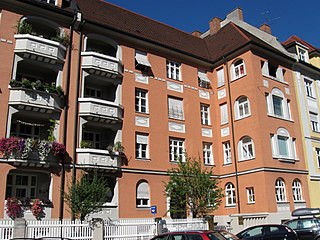You can help expand this article with text translated from the corresponding article in German. (November 2011)Click [show] for important translation instructions.
|

You can help expand this article with text translated from the corresponding article in German. (November 2011)Click [show] for important translation instructions.
|


The Feldherrnhalle is a monumental loggia on the Odeonsplatz in Munich, Germany. Modelled after the Loggia dei Lanzi in Florence, it was commissioned in 1841 by King Ludwig I of Bavaria to honour the tradition of the Bavarian Army.

Schwabing is a borough in the northern part of Munich, the capital of the German state of Bavaria. It is part of the city borough 4 (Schwabing-West) and the city borough 12 (Schwabing-Freimann). The population of Schwabing is estimated at about 100,000, making it one of the largest districts of Munich. The main boulevard is Leopoldstraße.

Raseiniai District Municipality is one of 60 municipalities in Lithuania.

Arróniz is a town and municipality located in the province and autonomous community of Navarre, northern Spain.

Au-Haidhausen is the 5th borough of the German city of Munich, Bavaria. It is formed by the Au and Haidhausen districts.

Donja Zleginja is a village in the municipality of Aleksandrovac, Serbia. According to the 2002 census, the village has a population of 296 people.

The Blauberge or Blauberg are a mountain range in the Bavarian Prealps on the border between the states of Bavaria in Germany and Tyrol in Austria. Its highest summit is the Halserspitze, or Halserspitz at 1,862 m.

Schwabinger Bach is a stream in Bavaria, Germany. It starts in the centre of Munich, flows through the Englischer Garten and flows into the Isar near Garching bei München.
Rohrer & Brammer was a theatre in Munich, Bavaria, Germany. It was closed in May 2010.


Leopoldstraße is a street in the Munich districts Maxvorstadt, Schwabing and Milbertshofen. It is a major boulevard, and the main street of the Schwabing district. It is a continuation of Ludwigstraße, the boulevard of King Ludwig I of Bavaria, north of the Siegestor.

Schwabinger 7 or Schwabinger Sieben is a tavern in the Feilitzschstraße in the area known as Münchner Freiheit in Munich, Germany. The name comes from the neighbourhood Schwabing and the 7 is the house number of the original establishment.
Since 1961, the Schwabing Art Prize has been awarded annually by the city of Munich to persons or institutions that have their seat in the Munich district Schwabing or whose achievements have been made "in the spirit of Schwabing tradition". It is based on a civic initiative of the writer Florian Seidl and the then Süddeutsche Zeitung co-partner Hans Dürrmeier.
Relief is an unincorporated community in Washington County, in the U.S. state of Ohio.

The Ungererstraße is a street about 2.5 km long in the Schwabing district of Munich.
The Feilitzschstraße is a roughly 450-meter-long street in Munich's Schwabing district. After the incorporation of Schwabing to Munich in 1891, it was renamed after the Bavarian State Interior Minister, Maximilian von Feilitzsch (1834–1913) in order to avoid confusion with the Maffeistraße in the old town.

Clemensstraße is a 1.76-kilometer-long street in Munich's Schwabing district. The street, named after Clemens August of Bavaria (1700–1761), labeled under the term Green Axis Schwabing is a participative model project for all Munich municipalities and Munich's longest bicycle road.

The Theatinerstraße is a street in Munich's old town. It connects the Odeonsplatz with the southern lying Marienhof and houses a number of classical buildings and several shops. The street received its name due to the adjoining Theatinerkirche; it used to be called Hintere Schwabinger Gasse.
48°09′40″N11°35′20″E / 48.16111°N 11.58889°E